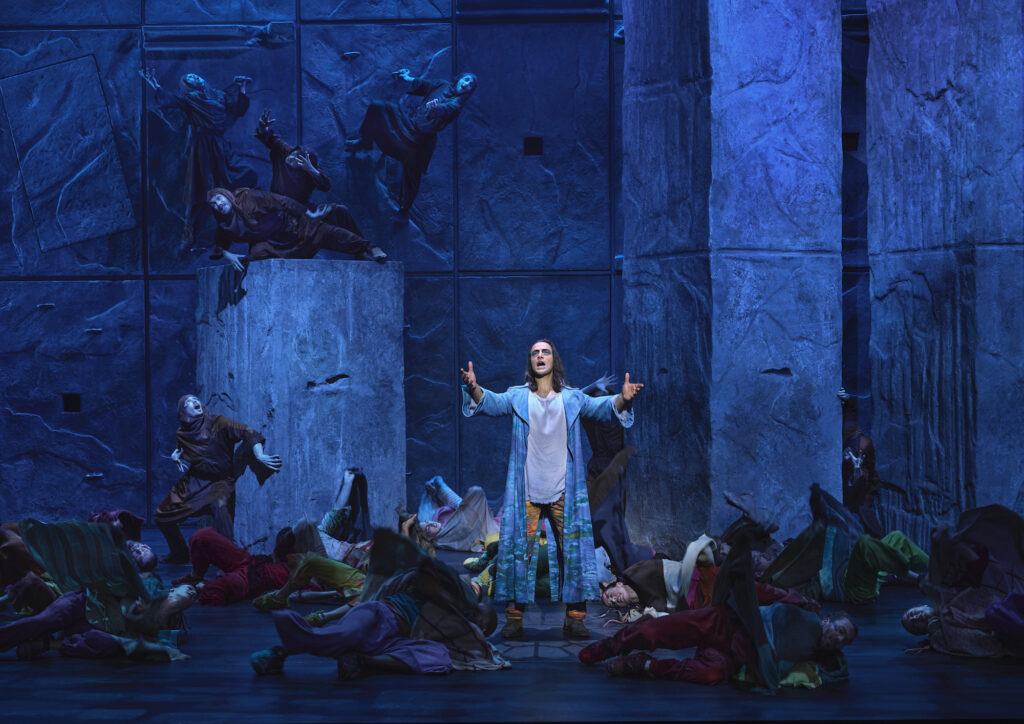Notre Dame De Paris: Reviving a Classic Story Through Song, Choreography, and Circus

International musical hitNotre Dame De Paris,written by Luc Plamondon and composed by Richard Cocciante, has been making its way around the globe for over two decades now and is currently being shown for a limited time in New York City (June 22-July 16) in its original French. Reaching thousands of audience members, this timeless piece of theatre, based on Victor Hugo’s 1831 novelThe Hunchback of Notre Dame, tells a tragic story of love, kinship, and the way inwhich discrimination persists nonetheless.Although the original work was written nearly two hundred years ago, it is not difficult to see how these ideas continue to be mirrored in our modern-day world.
Directed by Gilles Maheu, this production’s uniquely artistic approach to such an iconic story is one that pushes the boundary of what is possible on stage via not only the stagecraft but the incorporation of acrobatics into musical theatre. The ensemble of dancers and circus artists in this piece mostly serve a very literal role in the story’s telling. For the majority of the show, they are the so-called“gypsies,” “les sans-papiers,” or the undocumented immigrants who face continued repression at the hands of the Church and of society as a whole. With the use of metal police barricades as apparatuses and rather exaggerated, chaotic movement—particularly in the large group numbers outside of the cathedral—the ensemble raises the stakes of the especially intense moments in the fates of Esmeralda and her community. After all, although she proves to be the object of many characters’ desire (a few of whom harbor less than positive opinions on the “sans-papiers” as a whole), Esmeralda too is subject to similar treatment at the hands of her country.

Although the choreography was effective and held a strong presence in the numbers that it was used in, it felt like its full capacity had not been completely fulfilled, as it was largely missing from the more somber solo/duet numbers. Dance and circus have a unique power to express emotions via movement, and some of these opportunities were passed up in numbers that were not filled with chaotic rage. In that sense, the production sometimes lacks the connectivity of being both a concert-style work and a well-rounded musical (incorporating dance and song seamlessly). Primarily in Act I, it was almost jarring to see the cyclical pattern of the leads singing songs by themselves on stage, then quickly followed by a large, company-wide number, chock-full of acrobatics and movement. Act II, however, appeared to smooth itself out more by using dance and circus arts more often and in more diverse songs. [Spoiler alert!] For example, the final number, “Danse mon Esmeralda,” is a solo sung by Quasimodo as he holds a lifeless Esmeralda while three pairs of dancers mimic them, with each of their Esmeraldas attached to harnesses, floating. This moment particularly stood out as one wherein movement was coupled with Richard Cocciante’s emotionally evocative music rather seamlessly.

On a more general note, as a musical itself,Notre-Dame de Paris feels more heightened than perhaps a Broadway musical, and more closely mimics an opera with some Cirque du Soleil-esque visual drama. With the striking sets and choreography of the original 1998 version, the production continues to awe its audience as a true mammoth of a production. The talent of the singers, dancers, acrobats, and breakers is set against a tremendous backdrop designed by Christian Rätz: from gargoyles atop towering pedestals to bells with people as their clappers, the set really speaks for itself in how it serves this classic story. The colorful and textured costumes, with new designs by Caroline Van Assche, aid in bringing the story to life while leaving the exact time period deliberately ambiguous. Similarly, the powerful and eye-catching lighting looks designed by Alain Lortie dramatize and bring depth to the stage, while beautifully enhancing the plot and having a life of its own.Ultimately, by incorporating dance/circus and music,Notre Dame de Paris proves to be a sensational and multifarious production, set against a social landscape with elements that have persisted into the 21st century. It goes to show that theatre with high entertainment value can also have the capacity to honor a greater emotional depth in its storytelling.
Notre Dame de Paris currently plays in New York City at the David H. Koch Theater through July 16th.
Notre Dame de Paris was reviewed by Aryana Piros and Selina Piros.
Main image: Angelo Del Vecchio in the 2023 production of NOTRE DAME DE PARIS. Photo by Alessandro Dobici.Editor's Note: At StageLync, an international platform for the performing arts, we celebrate the diversity of our writers' backgrounds. We recognize and support their choice to use either American or British English in their articles, respecting their individual preferences and origins. This policy allows us to embrace a wide range of linguistic expressions, enriching our content and reflecting the global nature of our community.
🎧 Join us on the StageLync Podcast for inspiring stories from the world of performing arts! Tune in to hear from the creative minds who bring magic to life, both onstage and behind the scenes. 🎙️ 👉 Listen now!